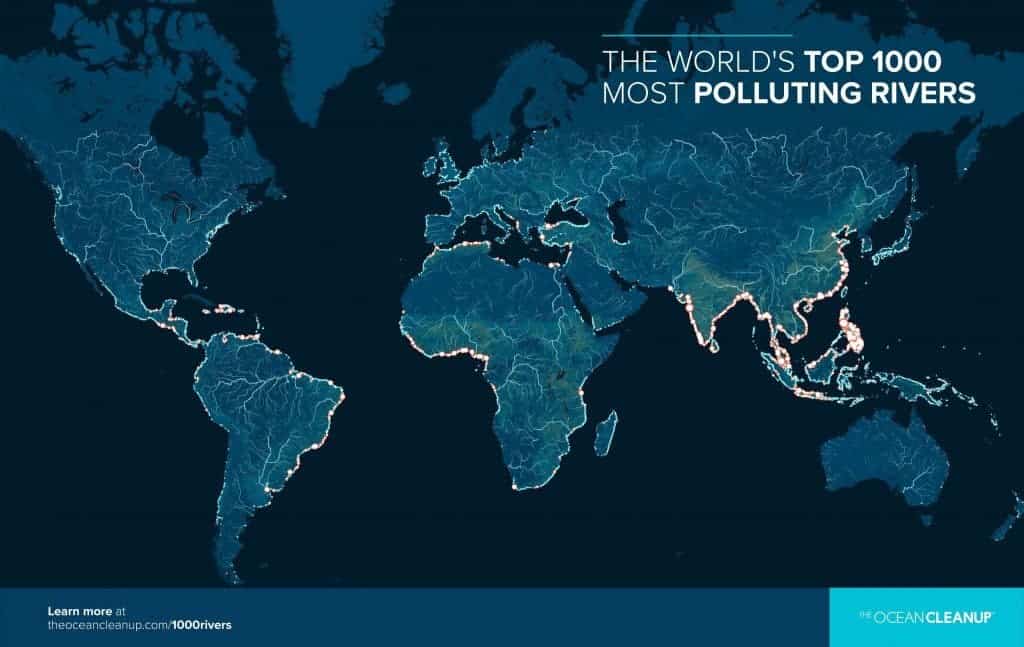The global plastic problem just got more complicated. In a new study, researchers found nearly 80% of the plastic pollution in the oceans comes from 1,000 rivers around the world. This contradicts previous studies that suggested only a handful of large continental rivers were the main culprits behind plastic pollution.

Plastic pollution in oceans and rivers is already one of the biggest environmental problems. Plastic is rapidly accumulating on riverbanks, deltas, coastlines, and in the oceans. Of all the plastics ever made to date, 60% have been discarded in landfills or in the natural environment – threating aquatic life, ecosystems and human health.
In 2017, two separate groups of scientists found that 90% of river-borne plastic waste that flushes into the oceans is conveyed by just a handful of large, continental rivers, such as Amazon, Nile and Yangtze – the world’s three longest rivers. Cleaning up those rivers, 30 in total, would largely contribute to solving the plastic problem, they claimed.
A new study has turned that idea on its head.
A team of researchers found most of the world’s plastic waste is distributed by more than 1,000 rivers — not 30. They also found that most of that waste is carried by small rivers that flow through densely populated urban areas, not the largest rivers, as claimed in previous studies.
“One big difference from a few years ago is we don’t consider rivers mere conveyor belts of plastics,” Lourens J.J. Meijer, the study’s lead author, told National Geographic. “If you put plastic into the river hundreds of kilometers from the mouth, it doesn’t mean that that plastic will end up in the ocean.”
The research is based on new modeling and was done by several of the same scientists involved in both 2017 river studies. The argue that the data available back then was limited and led to focusing on the size of the river basins and the population density. Now, they looked at plastic waste in 1,656 rivers, considering activity in those rivers as well as the effects of rainfall, wind currents, and terrain.
This is because plastic flows more easily into rivers from paved urban areas, for example, than it does in forests, and travels farther in rainy climates than dry ones. The researchers also considered for the study the proximity of landfills and dump sites to river banks, finding out that those within 10 kilometers of rivers are likely to spill into them.
The researchers found that the farther plastic waste has to travel along a river, the less likely it will actually reach the seas. They also discovered that small rivers on tropical islands in Indonesia and the Philippines carried a lot of plastic waste. The same was the case of rivers in Malaysia and Central American countries, which are also fairly short.
But that wasn’t the only discovery. They also found out that the way plastic flows into the oceans differs by climate. Rivers in tropical regions disgorge plastic into the seas continuously, while rivers in temperate regions can flush most plastic in a single month, usually August in the rainy season, or in single events, such as flash floods.
One thing that didn’t change from the previous 2017 studies was that most of the rivers that transport plastic are located in Asia. Of the first 50 rivers on the new list, 44 are in Asia, a reflection of population density, according to the authors. They also expressed concern for Africa in the near future as the population expands and the economy improves.
The study was funded by The Ocean Cleanup, a nonprofit founded by Boyan Slat, a Dutch entrepreneur that wants to clean up the ocean. The NGO has developed a trash-eating machine called the Interceptor to collect trash from rivers. In 2019, Slat said he would mass produce 1,000 Interceptors and deploy them within five years.
The study was published in the journal Nature Communications.









